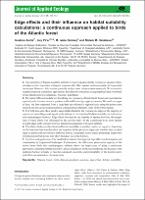Edge effects and their influence on habitat suitability calculations : a continuous approach applied to birds of the Atlantic forest
Date
2012-01-18Author
Zurita, Gustavo Andrés
Pe'er, Guy
Bellocq, Maria Isabel
Hansbauer, Miriam M.
Metadata
Show full item recordAbstract
1. The suitability of human-modified habitats for native species and the response of species to habitat edges are two important ecological processes that affect species and communities in fragmented landscapes. However, field studies generally analyse these two processes separately. We extended a recently proposed continuous approach to link these two processes, using empirical data from birds of the Atlantic forest in Argentina, Paraguay and Brazil.
2. We tested different models for describing the responses of birds (both forest and open-habitat species) to the interior–exterior gradient within different edge types (ecotones). We used two types of data: the first originated from a large data set collected at regional scale using the point-count method and the second originated from a detailed local telemetry study of three bird species.
3. For both data sets, these models successfully described the responses to edges of the majority of species and assemblages and significantly influenced the calculated habitat suitability in both native and anthropogenic habitats. Edge effects were seen in the majority of species; however, the magnitude of these effects was influenced by the ecotone type. At the assemblage level, more species avoided edges in the ecotone with tree plantations compared with open habitats.
4. The effect of edges on the calculated habitat suitability was either positive or negative, depending on the function that best described the response of the species to edges and whether they avoided edges or penetrated into the less-preferred habitat. In general, forest species penetrated deeper into tree plantations but moved only short distances into open habitats.
5. Synthesis and applications. Our results demonstrate the impact of edge effects on bird species and communities in fragmented landscapes. Furthermore, the differential penetration capacity of the native forest birds into anthropogenic habitats shows the importance of using a continuous approach to calculate habitat suitability; classic calculation (without considering the distance to the preferred habitat) is likely to bias the calculated suitability and permeability of the hostile matrix and affect our estimations of connectivity.
Collections
The following license files are associated with this item:



